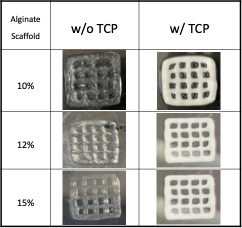IADR Abstract Archives
Acellular 3D-bioprinted Alginate-Based Bioink Scaffolds for Bone Tissue Engineering Applications
Objectives: The aim of this study was to develop a 3D-printable, tricalcium phosphate (TCP)-based acellular scaffold using alginate, gelatin, and other composite materials. By utilizing a multivalent cation (Ca2+) as a crosslinking agent, we aimed to achieve a specific shape suitable for bone tissue regeneration. We evaluated the physical and biological properties of scaffolds with varying alginate concentrations (10%, 12%, and 15%) combined with 5% TCP.
Methods: Our bioink was prepared with gelatin, glycerol, sodium alginate, and β-TCP powder. It was then homogenized, and loaded into a Cellink® BioX printer. The 3D scaffolds were printed and crosslinked with CaCl2. Physical properties were assessed through viscosity analysis, SEM, EDS, FTIR, swelling/degradation rates, and contact angle measurements. Each test condition was performed on five samples of each scaffold type. For the biological assessment, MG-63 human osteoblast cells were seeded onto the scaffolds and cultured in osteogenic differentiation media. Cell viability was evaluated using the AlamarBlue assay, and alkaline phosphatase (ALP) activity was quantified. Osteogenic gene expression was analyzed using quantitative polymerase chain reaction (qPCR) to evaluate the osteogenic differentiation potential of the cells on the scaffolds. The data was analyzed using a two-tailed Student's t-test for statistical significance.
Results: The scaffold was composed of 10% alginate with β-TCP exhibited optimal printability, swelling capability, and degradability, making it conducive for cell growth and nutrient diffusion. These scaffolds effectively supported the growth and proliferation of MG-63 human osteoblasts, underscoring their potential applicability in bone regeneration. Furthermore, the inclusion of β-TCP particles significantly enhanced osteogenic differentiation, as evidenced by the upregulated expression of osteogenic gene markers (OC, OPG).
Conclusions: To sum up, the 10% alginate hydrogel with bone-like β-TCP is an appropriate acellular-based bioink candidate for scaffold fabrication. Its potential to enhance the repair of bone defects makes it a promising prospect in bone regenerative medicine.
Methods: Our bioink was prepared with gelatin, glycerol, sodium alginate, and β-TCP powder. It was then homogenized, and loaded into a Cellink® BioX printer. The 3D scaffolds were printed and crosslinked with CaCl2. Physical properties were assessed through viscosity analysis, SEM, EDS, FTIR, swelling/degradation rates, and contact angle measurements. Each test condition was performed on five samples of each scaffold type. For the biological assessment, MG-63 human osteoblast cells were seeded onto the scaffolds and cultured in osteogenic differentiation media. Cell viability was evaluated using the AlamarBlue assay, and alkaline phosphatase (ALP) activity was quantified. Osteogenic gene expression was analyzed using quantitative polymerase chain reaction (qPCR) to evaluate the osteogenic differentiation potential of the cells on the scaffolds. The data was analyzed using a two-tailed Student's t-test for statistical significance.
Results: The scaffold was composed of 10% alginate with β-TCP exhibited optimal printability, swelling capability, and degradability, making it conducive for cell growth and nutrient diffusion. These scaffolds effectively supported the growth and proliferation of MG-63 human osteoblasts, underscoring their potential applicability in bone regeneration. Furthermore, the inclusion of β-TCP particles significantly enhanced osteogenic differentiation, as evidenced by the upregulated expression of osteogenic gene markers (OC, OPG).
Conclusions: To sum up, the 10% alginate hydrogel with bone-like β-TCP is an appropriate acellular-based bioink candidate for scaffold fabrication. Its potential to enhance the repair of bone defects makes it a promising prospect in bone regenerative medicine.

